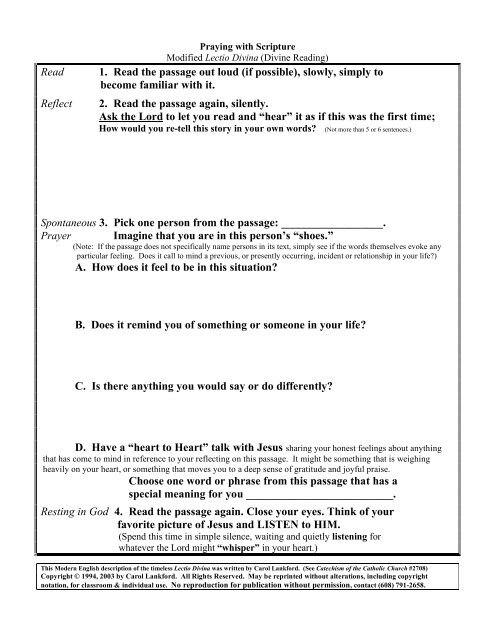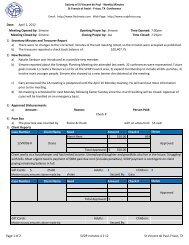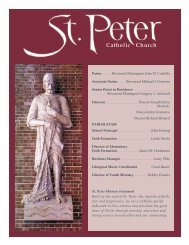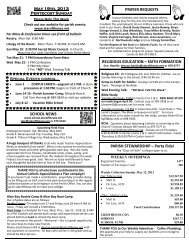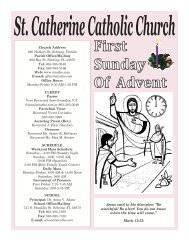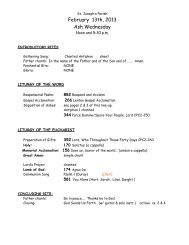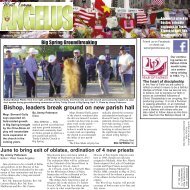Praying with Scripture.pdf - Flocknote
Praying with Scripture.pdf - Flocknote
Praying with Scripture.pdf - Flocknote
Create successful ePaper yourself
Turn your PDF publications into a flip-book with our unique Google optimized e-Paper software.
<strong>Praying</strong> <strong>with</strong> <strong>Scripture</strong><br />
Modified Lectio Divina (Divine Reading)<br />
Read 1. Read the passage out loud (if possible), slowly, simply to<br />
become familiar <strong>with</strong> it.<br />
Reflect 2. Read the passage again, silently.<br />
Ask the Lord to let you read and “hear” it as if this was the first time;<br />
How would you re-tell this story in your own words? (Not more than 5 or 6 sentences.)<br />
Spontaneous 3. Pick one person from the passage: __________________.<br />
Prayer Imagine that you are in this person’s “shoes.”<br />
(Note: If the passage does not specifically name persons in its text, simply see if the words themselves evoke any<br />
particular feeling. Does it call to mind a previous, or presently occurring, incident or relationship in your life?)<br />
A. How does it feel to be in this situation?<br />
B. Does it remind you of something or someone in your life?<br />
C. Is there anything you would say or do differently?<br />
D. Have a “heart to Heart” talk <strong>with</strong> Jesus sharing your honest feelings about anything<br />
that has come to mind in reference to your reflecting on this passage. It might be something that is weighing<br />
heavily on your heart, or something that moves you to a deep sense of gratitude and joyful praise.<br />
Choose one word or phrase from this passage that has a<br />
special meaning for you __________________________.<br />
Resting in God 4. Read the passage again. Close your eyes. Think of your<br />
favorite picture of Jesus and LISTEN to HIM.<br />
(Spend this time in simple silence, waiting and quietly listening for<br />
whatever the Lord might “whisper” in your heart.)<br />
This Modern English description of the timeless Lectio Divina was written by Carol Lankford. (See Catechism of the Catholic Church #2708)<br />
Copyright © 1994, 2003 by Carol Lankford. All Rights Reserved. May be reprinted <strong>with</strong>out alterations, including copyright<br />
notation, for classroom & individual use. No reproduction for publication <strong>with</strong>out permission, contact (608) 791-2658.
LEADER’S/TEACHER'S INSTRUCTION SHEET<br />
Directions to accompany the use of<br />
"<strong>Praying</strong> <strong>with</strong> <strong>Scripture</strong>" Lectio Divina prayer worksheet<br />
INTRODUCTION:<br />
“<strong>Praying</strong> <strong>with</strong> <strong>Scripture</strong>” is intended for all ages.<br />
This handout is effective in the classroom, home school settings, and small groups of adults – or for individual use.<br />
Families have effectively incorporated this Scriptural progression, leading to prayer, into their devotional time together.<br />
It provides an opportunity for participation by all members. Parents and/or children can take turns reading the passage<br />
aloud, followed by telling the story in their own words. Even “little ones” and pre-readers can “pick a favorite person” in<br />
the passage – following the steps and answering the questions posed in Step 3. The steps described can seem almost too<br />
simplistic—most people are surprised at how the Holy Spirit uses this manner of prayer so powerfully to make a<br />
connection to one’s own life. Don't skip any steps!<br />
SELECTING THE SCRIPTURE PASSAGE:<br />
It is best to begin using narrative passages <strong>with</strong> people (i.e. the Visitation, the Finding in the Temple). This facilitates the<br />
student’s immersion in the Scriptural passage through a specific person, and this personally related identification allows<br />
him/her to be more readily open to the truth God desires to reveal. It’s easier, initially, to identify <strong>with</strong> Elizabeth, the<br />
centurion, or a shepherd…than concepts such as the “poor in spirit” or one who desires to “enter through the narrow<br />
gate.”<br />
As the students advance, passages <strong>with</strong>out names of specific people can be selected. To answer the questions in number<br />
3, tell the students to simply see if the words themselves evoke any particular feeling. Do they call to mind a previous, or<br />
presently occurring, incident or relationship in their life?<br />
Initially, select 20-25 verses for each meditation. If that seems to be too much, use 10-15 verses.<br />
Some Suggested <strong>Scripture</strong>s for use <strong>with</strong> the prayer worksheet<br />
Luke 1: 26-38 The Annunciation to Mary<br />
Luke 2: 1-20 The Birth of Jesus<br />
Luke 22:1 - 20 Jesus institutes the Holy Eucharist on Holy Thursday<br />
Luke 22:39 - 65 Jesus’ Agony in the Garden and Arrest<br />
Luke 23:33 - 56 The Crucifixion and Death of Christ<br />
John 20:11-18 Jesus Appearance to Mary Magdalene after the Resurrection<br />
Acts 2:1-4 Pentecost: Public manifestation of the Church<br />
(could also include 2:5-15, 22-24, 32-33, 36-40)<br />
PRIOR TO TAKING STUDENTS THROUGH PRAYING WITH SCRIPTURE:<br />
It's important that the leader/teacher has prayed through the passage using the described progression himself/herself prior<br />
to guiding others through it.<br />
CREATING AN ATMOSPHERE FOR PRAYER<br />
It is crucial that a proper atmosphere for prayer be created. The enthusiasm, yet reverential awe, <strong>with</strong> which the<br />
leader/teacher approaches Sacred <strong>Scripture</strong>, impressionably conveys to the students an understanding that this is, indeed,<br />
the very Word of God, empowered by the Holy Spirit, and capable of transforming—positively, joyously—our lives, our<br />
world, to the glory of God. It is said that Christianity is not so much taught, as “caught”, and in a very significant sense,<br />
this is true of prayer, the heart of our Catholic Faith.<br />
One of the ways we can engender and maintain this respect for God’s Holy Word is by impressing upon the students the<br />
importance of silence during the actual time of prayerful meditation (note that following Step 1, no words need be<br />
spoken). To foster an environment of “heart to Heart conversation” and subsequent “listening,” silence must be<br />
practiced in order to be personally experienced; it does not come naturally in our noisy, distractible world. As the<br />
students become familiar <strong>with</strong> and are guided appropriately through this process, they will come to love, and be<br />
irresistibly drawn to, the peace and freedom of silent communion <strong>with</strong> the Lord Jesus.<br />
STUDENT INSTRUCTION PRIOR TO USING THE HANDOUT:<br />
Prior to beginning the actual meditation, give an overview of the progression from step to step. Explain to the<br />
participants that this is a simple progression allowing one to meditate (ponder) on a passage of God's Word.
Explain that, for the first step, you will read the passage out loud and they should listen carefully (not reading along in<br />
their own Bible, due to different translations but more importantly as step one is, above all, about “hearing” the passage.<br />
In the second step, they will read the passage silently, asking Jesus to help them understand its meaning. Following this<br />
silent reading, they will “re-write” it in their own words, as if explaining it to a small child, perhaps a younger brother or<br />
sister. (Initially, students will give merely a reiteration of the events of the text. As they have more opportunity to<br />
practice Lectio, encourage and affirm them when they use words that display their understanding of the meaning of the<br />
passage, even using fewer sentences to describe the passage.)<br />
In the third step, instruct them to choose a person to whom they feel “drawn”, or <strong>with</strong> whom they can somehow<br />
identify. It is important to discuss the possibilities for their choice of a person. For example, in the “Finding in the<br />
Temple” they can choose to “walk in the shoes” of Jesus, Mary, or Joseph; one of the Temple teachers; or any person<br />
Mary and Joseph met in seeking their Son. If they’re not drawn to a particular person, encourage them to be present as a<br />
"silent observer."<br />
Proceed in briefly pointing out the responses requested of them in points A—D. (This “walking” through the passage in<br />
the shoes of the person they’ve chosen allows them to “make it their own,” to be increasingly open to the heartfelt<br />
movements of the Holy Spirit. The narrative, and the truth it contains, is deposited more permanently in the storehouse<br />
of their mind and heart.)<br />
Note that the question, “Is there anything you would say or do differently?” refers to their own personal life experience<br />
as recalled to their remembrance through the passage.<br />
[Along <strong>with</strong> the other questions, it is aimed at a natural, “unforced” personal application and possible resolution.<br />
Sometimes, a student will reply in reference to the person they’ve chosen from the passage (i.e., as “Peter” – expressing<br />
regret for having denied Jesus). This, too, is beneficial.]<br />
After completion of points A – D, they are to transition to the fourth step and enter into the silent prayer in<br />
accordance <strong>with</strong> the time allotted<br />
Tell them you will quietly announce the close of the meditation <strong>with</strong> a vocal group prayer by asking everyone to pray the<br />
Our Father.<br />
AFTER THE MEDITATION IS FINISHED:<br />
Ask for volunteers to give their responses/reflections. One or two can read their “summary” from Step 2. Always ask<br />
which person they chose from the passage; also, ask which word or phrase they chose and why it had a special<br />
meaning.<br />
It's beneficial, if any are willing, to briefly share points A—D in Step 3. Leaders/Teachers should be<br />
careful to affirm student's personal responses unless, of course, they have expressed error in<br />
understanding objective truth.<br />
SUMMARY OF STEPS AND SUGGESTED TIMES:<br />
1. Read the passage out loud. [3 min.]<br />
2. Students/adults silently read it again [3 min.]<br />
and write out the main points.<br />
3. Follow the instructions— answer the questions as [6 min.]<br />
indicated. It requires a 3rd "closer look" at the text.<br />
Responses are written on the handout or in a prayer journal.<br />
4. Students/adults close their eyes and silently [3 min.]<br />
"listen" to Jesus.<br />
Remember, the purpose of this prayer "exercise" is not only to get to know Jesus better through greater intellectual<br />
knowledge and remembrance of <strong>Scripture</strong>, but even more importantly, to facilitate an opening to a greater "heart<br />
knowledge" of our Divine Savior. As students become accustomed to praying in this manner, the time allotted for Step 4<br />
may gradually be extended.<br />
This Modern English description of the timeless Lectio Divina was written by Carol Lankford. (See Catechism of the Catholic Church #2708)<br />
Copyright © 1994, 2003 by Carol Lankford. All Rights Reserved. May be reprinted <strong>with</strong>out alterations, including copyright<br />
notation, for classroom & individual use. No reproduction for publication <strong>with</strong>out permission, contact (608) 791-2658.


